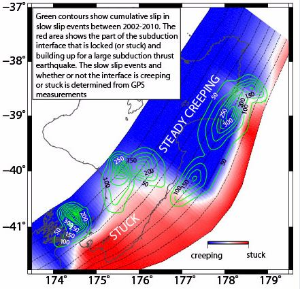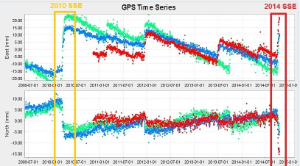
Return of the Gisborne Slow-Slip Event
The Gisborne area is no stranger to “silent” earthquakes or, as our seismology friends like to call these: the 'slow-slip event ' (SSEs).
We've recorded several SSEs over the past decade or so in the Gisborne area but its been quiet for the last 18 months. Two weeks ago, our GPS system started picking up some movement again. After monitoring our equipment closely to ensure we had another SSE going on, we can now confirm that there is an SSE occurring right now in the Gisborne area, and showing signs of being similar to the one in March 2010 .
We sat down with Stephen Bannister, one of our top seismologists at GNS Science, to get the lowdown on the events currently going on in Gisborne and what it means for people in the area:
Q. How frequently do we get SSEs in the Gisborne area?
SSEs large enough to detect occur about every 18 months in the Gisborne area, although these can vary in size a bit. The last SSE of this size in the region occurred back in March 2010, south-east of Gisborne and north-east of Mahia peninsula.
Q. Do you think this SSE will cause more earthquakes? Should we be preparing for more earthquakes in the region?
SSEs sometimes trigger multiple magnitude 2 to 4 earthquakes around their periphery; but in the last two weeks there hasn't been much significant seismic activity observed for this new SSE. Having said that, the science regarding SSEs is relatively new; we've only been aware of this phenomenon for the last decade. The best advice regarding this event is to be prepared for earthquakes anyway; we can get large earthquakes anywhere in New Zealand, it’s just that some areas are more likely than others to get these. You should always be prepared for earthquakes.
Q. On the flip side of the previous question, does an SSE mean that we might have fewer earthquakes? Does it relieve the pressure on the faults?
Based on our current understanding: yes. The SSEs do relieve stress in the areas where they occur on the thrust interface, approximately 15 km below the earth’s surface, as they represent large-scale creep on the thrust fault. Having said that, SSEs may transfer stress to surrounding areas and potentially trigger earthquakes on their periphery; what the size and strength of those potential earthquakes would be is impossible to predict at the moment.
Q. How much land movement are we talking about here? Should we be purchasing more beach front property in Gisborne with the hopes of getting extra land out of it?
Well…up to 3 cm can possibly be displaced sideways, which is about the length of a pineapple lump (it's before lunch and I'm hungry). This is mostly an eastwards direction; but less than that in the vertical direction. To compare to the previous SSE in Gisborne in March 2010, some of the GeoNet sites experienced horizontal shifts of up to 5 cm. This new SSE looks smaller than that 2010 SSE. In other words, we are very slowly moving towards Chile's coast. I'm kidding. Mostly. I mean, we might get there in about a billion years or so...never mind. This means some beachfront property would move slightly towards the dateline but it wouldn’t be much vertically. Beachfront property in Gisborne would likely be unaffected by this SSE.
Q. How do we know when an SSE is occurring?
There is a network of continuously recording GPS stations across New Zealand, which is operated and monitored by GeoNet, which is funded by EQC, GNS Science and Land Information New Zealand (LINZ). These geodetic stations are very sensitive and can detect changes in position of the order of millimetres. When a SSE occurs, several GPS stations, (which are roughly 20 km apart) are displaced at the same time, both horizontally and vertically. From examining the GPS data we can then calculate the amount of slip involved for that SSE.
Q. So why are studying SSEs so important?
Hopefully, by observing this phenomena, we will gain important insights into why earthquakes occur, where these occur most frequently and how earthquakes are related to each other.






